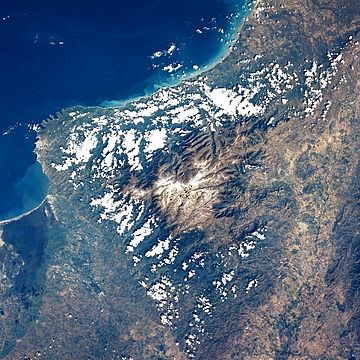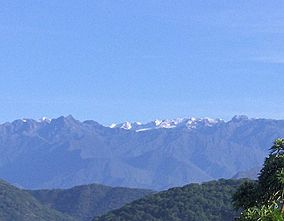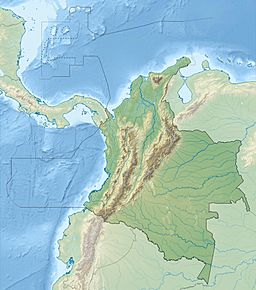Sierra Nevada de Santa Marta facts for kids
Quick facts for kids Sierra Nevada de Santa Marta |
|
|---|---|
 |
|
| Highest point | |
| Peak | Pico Simón Bolívar and Pico Cristobal Colon |
| Elevation | 5,710 m (18,730 ft) |
| Dimensions | |
| Length | 162 km (101 mi) |
| Geography | |
| Country | Colombia |
| PNN Sierra Nevada de Santa Marta | |
|---|---|
| Sierra Nevada de Santa Marta National Natural Park | |
|
IUCN Category II (National Park)
|
|

Sierra Nevada viewed from Valledupar
|
|
| Nearest city | Santa Marta, |
| Area | 3,830 km2 (1,480 sq mi) |
| Established | 1964 |
| Governing body | SINAP |
The Sierra Nevada de Santa Marta is a special mountain range in northern Colombia. It stands alone, separate from the larger Andes mountains that run through the country. This makes it very unique!
This mountain range is super tall, reaching about 5,700 meters (18,700 feet) high. What's amazing is that it's only 42 kilometers (26 miles) away from the Caribbean coast. This makes the Sierra Nevada the highest coastal mountain range in all the tropical parts of the world. It's also one of the highest coastal ranges anywhere!
The Sierra Nevada covers a large area, about 17,000 square kilometers (6,600 square miles). Many rivers, around 36 of them, start here. These rivers are very important for the people living nearby. The range is located in three different parts of Colombia: Magdalena, Cesar, and La Guajira.
The very highest points in the Sierra Nevada, and in Colombia, are Pico Cristóbal Colón and Pico Simón Bolívar. Scientists are still figuring out which one is exactly taller. They are both about 5,700 meters (18,700 feet) high. The Sierra Nevada is also known for being very "prominent," meaning it rises sharply from flat land around it. This makes it one of the most prominent peaks in the world!
Contents
Climate and Weather in the Mountains
The Sierra Nevada de Santa Marta has a lot of rain, especially at certain heights. Between 500 and 1,500 meters (1,600 to 4,900 feet) above sea level, it rains about 4,000 millimeters (157 inches) each year. That's a lot of water! The temperature changes quite a bit, from 0°C (32°F) in the colder, higher parts to 27°C (81°F) in the warmer, lower areas.
Amazing Plants and Animals
The Sierra Nevada is bursting with life, from its warm coastal areas to its cold, snowy peaks. It's like many different worlds packed into one place!
Forests and Plant Life
The lower parts of the mountains have tropical rainforests. Here, trees can grow very tall, up to 30 to 40 meters (100 to 130 feet) high. These forests are full of different kinds of plants, including many epiphytes (plants that grow on other plants) and lianas (vines). There are more than 3,000 different types of plants found here. Local people even used to make a drink from the fruit of a palm tree called Attalea maripa.
Animals and Birds
This area is a special home for many animals. Out of all the animal species found only in Colombia, 44 of them live here! This includes seven types of hummingbirds that you won't find anywhere else.
The Sierra Nevada is also a birdwatcher's paradise, with 440 different bird species. Some of these include the king vulture, the huge Andean condor, and special birds like the Santa Marta warbler and Santa Marta parakeet.
You can also find many mammals here, such as tapirs, cougars, jaguars, squirrels, otters, and brocket deer. It's a truly wild place!
Different Natural Zones
The Sierra Nevada has several different natural zones, called ecoregions, which change as you go higher up the mountain:
- Dry Coastal Areas: Near the Caribbean Sea, there's a dry area called the Guajira–Barranquilla xeric scrub.
- Dry Forests: On the lower slopes, up to 500 meters (1,600 feet), you'll find Sinú Valley dry forests.
- Mountain Forests: Above 500 to 800 meters (1,600 to 2,600 feet) are the Santa Marta montane forests. These forests are special because they are cut off from other moist forests, so they have many unique plants and animals found nowhere else.
- Cloud Forests: Even higher, above 1,000 meters (3,300 feet), are Cloud forests. These forests are often covered in mist and clouds.
- High Mountain Grasslands: Between 3,300 and 5,000 meters (10,800 to 16,400 feet) is the Santa Marta Páramo. This area has grasslands, marshes, and bogs. It's the northernmost place in South America where you can find this type of high-altitude grassland.
- Snowy Peaks: Above 5,000 meters (16,400 feet), the mountains are covered in permanent snow and ice.
Sierra Nevada de Santa Marta National Natural Park
The Sierra Nevada de Santa Marta National Natural Park is a very important protected area. It was created in 1964, making it Colombia's second oldest national park. It's located across the La Guajira, Magdalena, and Cesar departments.
This park is a special place for both nature and visitors. You can find everything from beaches to snowy mountain peaks here! It's considered unique because it's so isolated from the main Andes mountain range. Its highest peak is only 42 kilometers (26 miles) from the sea.
All the rivers that start in the park flow towards the Caribbean Sea. Some flow directly, like the Ranchería and Palomino rivers. Others flow into the Magdalena River system, which then reaches the sea. About 1.2 million people rely on the fresh water that comes from these mountains.
Indigenous Communities
The park is also home to about 30,000 indigenous people from the Koguis, Arhuacos, Kankuamos, and Wiwa groups. They have lived in these mountains for a very long time and have a deep connection to the land. The park also protects the remains of the ancient Tairona culture.
In 1979, UNESCO named the park a Biosphere Reserve. This means it's recognized globally for its important natural and cultural value. A report in 2013 even called it the most irreplaceable park in the world for protecting endangered species!
Mountain Rocks and Landforms
The Sierra Nevada mountains are made of very old rocks. Most of them are metamorphic rocks like schists and gneisses, which have been changed by heat and pressure. There are also younger rocks formed from magma that pushed up into the earth. The coastlines here are very interesting, with rocky cliffs and deep bays. These bays were formed by the movement of the Earth's crust. The beaches are often steep and made of coarse sand from the nearby cliffs.
Special Animals of the Sierra Nevada
The Sierra Nevada is so unique that some animals found here are named after it! For example, there are three types of reptiles:
- Anolis santamartae, a lizard.
- Atractus sanctaemartae, a snake.
- Lepidoblepharis sanctaemartae, another lizard.
About 20 different bird species are found only in this mountain range and nowhere else in the world!
People of the Sierra Nevada
The Sierra Nevada de Santa Marta is the home of the descendants of the ancient Tairona culture. Today, the Arhuacos, Koguis, Wiwas, and Kankuamos indigenous groups live in special areas called Resguardos Indigenas (indigenous reserves) in the middle and higher parts of the mountains. They work to preserve their traditions and their land.
Visiting the Highest Peaks
For a while, it was very hard to visit the highest peaks of the Sierra Nevada. This was partly because local communities on the southern side of the mountain didn't want climbers to explore the area. Their permission is important for a successful climb. Also, past conflicts in Colombia made it difficult to access the area safely.
However, there was a successful climb of Pico Cristóbal Colón in December 2015. The safest way to visit part of the mountains is from Santa Marta city to Cuchillo de San Lorenzo. This path goes up to 2,800 meters (9,200 feet) and offers amazing views of the snowy peaks!
See also
 In Spanish: Sierra Nevada de Santa Marta para niños
In Spanish: Sierra Nevada de Santa Marta para niños


